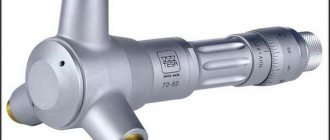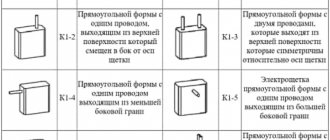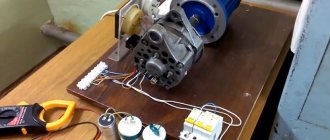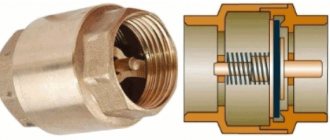The measurement rules state that a voltmeter is connected to the required section of the electrical circuit in parallel, and an ammeter in series. Therefore, in order to measure the current strength, it is necessary to artificially create an open circuit and connect a measuring device to it. To simplify and speed up measurements, current clamps are used, which work using a fundamentally different method - their device allows you to measure the intensity of the electromagnetic field that always arises around the conductor.
Current clamp device
Initially, an electrical clamp was a transformer to which a measuring device, an ammeter, was connected.
The clamps, which are the visible part of the device, are also the primary winding of the transformer. If a conductor is placed inside it through which an electric current flows, then thanks to the electromagnetic field it is induced onto the winding of the transformer. Next, the current passes to the secondary winding, from which readings are taken with an ammeter.
The first models of clamps were created as an addition to measuring instruments, simply allowing more convenient contact with the measured section of the chain.
The ammeter readings obtained with their help had to be additionally recalculated, taking into account the transformation ratio that was indicated on the device. Also, the principle of operation itself made it possible to measure only alternating current values, since the transformer does not work with constant current - in order to measure it, it was necessary to use other devices.
Modern instruments can be used both for alternating current and as a clamp for accurate measurement of direct current, but in the latter case, such devices do not use an ammeter, but a Hall sensor, which directly senses the presence and strength of the electromagnetic field.
Such models are somewhat more expensive, but are distinguished by higher quality and accuracy of work.
Also, using a clamp meter paired with a digital multimeter eliminates the need for the operator to calculate the measured current value, since the calculator is already built into the device circuit.
The best budget pliers
6 UNI-T UT204A
Budget multifunctional current clamps from the well-known company UNI-T.
The location of the controls is very convenient, allowing you to operate with one hand when measuring currents in a non-contact manner. Very simple control, since the only controls are a rotary switch and three buttons. To protect against falling of the device, a lanyard is included in the kit.
Control buttons:
- SELECT – selection of a submode that corresponds to the blue rotary switch inscriptions;
- REL - zero setting with additional capabilities;
- HOLD – fixation of display readings.
An interesting solution is to separate the measured parameters by direct and alternating current, which greatly simplifies the control of the device as a whole.
There is an auto shut-off function that occurs after 15 minutes of inactivity. Pros:
- famous brand, good workmanship;
- high measurement speed;
- sufficient accuracy and stability of measurements;
- automatic range selection;
- non-contact measurement of direct and alternating current up to 600A;
- convenient control, compact size;
- huge functionality;
- low cost.
Minuses:
- power from the crown;
- no backlight;
- no TRUE RMS;
- the body is not rubberized;
- The ADC chip is unpackaged, filled with compound;
- The magnetic circuits are too small.
Capabilities of clamp meters
If clamps were initially created as an addition to professional measuring instruments, then further industry opportunities for miniaturization and simplification of devices made this device relatively inexpensive and accessible to ordinary users for domestic use.
At the same time, the scope of its use is constantly growing and only standard tasks that can be performed with its help include the following items:
- Measuring the current strength in a single conductor, which is not only not disconnected from the circuit, but is also energized.
- Determination of the actual power of any electrical appliance at different times and depending on the load.
- Determination of the actual load on the entire electrical network of a house or apartment “in real time”.
- Checking the electrical network for unauthorized connections.
- Checking for current leakage on the body of the electrical appliance.
Video of work and instructions
The operation of the device is based on the law of electromagnetic induction, when a passing current creates an electron-magnetic field around itself, which, under certain conditions and high-quality measurements, gives an objective picture of the power component of the current.
The design of current clamps is almost the same for all. It includes:
- spring-loaded magnetic circuit of detachable type;
- multi-turn coil that creates EMF (electromotive force);
- range switch for working with different currents;
For different current strengths, different handles and holders are used. For low-voltage measuring instruments there are no handles, and the holding occurs by the body, which is a dielectric. For higher values of the measured medium - handles with complete, sometimes double, insulation of the measuring circuit and the operator. Current clamps are divided according to power and the structure of the handles.
Advantages and disadvantages
Current clamps have become widespread due to a number of advantages that determine the choice in their favor, if necessary, have a corresponding device “on hand”:
- The maximum possible simplicity, device size and measurement accuracy.
- Possibility of use for measurements in high-voltage circuits and microcurrents.
- The operating principle of pliers allows you to create devices of various designs and functionality.
- Easy integration with other electrical measuring devices. For example, current clamps combined with a multimeter have proven to be very effective - the limits of possibilities for household use for such devices are very difficult to imagine, since they can be equipped with a temperature sensor and other “goodies” that expand the functionality.
The device is extremely easy to use; its development, even on an intuitive level, is accessible to anyone who is even more or less familiar with the basics of electrical engineering.
When using electrical clamps, one must take into account some of the inherent disadvantages of such devices:
- Since the device reacts to an electromagnetic field, there is some dependence on the position of the wire inside the primary winding (ring) and its position - it is advisable to place the clamps perpendicular to the conductor being measured.
- A sensitive device can be very susceptible to interference currents that can occur when there are a large number of conductors close to what is being measured.
- The simplicity of the device design opens up wide opportunities for the production of low-quality clones of devices from reputable manufacturers. Such copies are not equipped with proper protection schemes and the accuracy of their readings leaves much to be desired.
Basic operating principles
Fundamental techniques for working with current clamps - when measuring, only one wire is covered or clamped so that the value is as close as possible to the true one. In the case of crimping groups of wires, the device shows the mathematical sum of the values of all currents in the wires (when crimping both wires in a single-phase circuit, the clamps will show zero).
In many ways, the price and level of accuracy of measurements depends on the configuration of the device. A mechanical magnetically dependent pointer operating in an electromagnetic field is much cheaper than a liquid crystal display with multifunctional indicators.
They are, perhaps, one of the most common tools among professional and not so professional electricians. The main advantage of this device is the ability to measure electric current without breaking the electrical circuit. Measurements can be made in a functioning electrical circuit without disrupting its operation.
This is the only device of its kind capable of performing such operations. At the same time, current clamps
can be used in electrical installations up to 10,000 V. This, in turn, greatly expands the range of their professional use.
Although they will also be useful in everyday life, for example, for measuring the network load in an apartment
or house.
Clamp meter
A very useful
electrician's tool
, however, many people simply do not know about it and what it is needed for. This, in part, explains the reason for its not being so widespread.
Types of current clamps
Depending on the circuit used and even the appearance of the device itself, electrical clamps are divided into several types:
- Switches. An analog type device, the active part of which is a single-turn AC transformer, and the measuring device is connected to its secondary winding. These are one of the first models of current clamp meters - they are distinguished by their low cost and clear display of measurement results in the case of variable current. A common disadvantage of such devices is their high sensitivity to mechanical vibrations - if the device is not placed on a hard surface, the measurement result may be displayed incorrectly. Also, to use such devices you need a certain skill - you often have to manually convert the ammeter readings into real values in accordance with the transformation ratio. This device is also designed for a certain frequency of electric current.
- Digital. The display of readings on such a device is determined by a microcontroller, which automatically performs all the necessary calculations and (depending on the model) can be configured to directly display current or power.
- Multimeter. A universal all-in-one device - the measuring clamps are built directly into the body of the device, which makes it easy to use. The number of functions and measurement methods is determined by the model of the multimeter, so the correct name for the device would not be an electric clamp with a multimeter, but vice versa. Often such devices work with a Hall sensor, so they can be used as DC current clamps.
- High voltage. The main application is electrical circuits with standard frequency current and voltage exceeding 1 kV. Such devices have increased insulation resistance and can additionally be mounted on a dielectric rod so that the operator does not come close to the conductor from which measurements are taken. This is a specialized professional device that is designed for only one single function - measuring alternating current. If it is necessary to measure the direct current, other devices and methods are used.
Measurement with DC and AC clamps
To measure different types of current using clamps, exactly the same technique is used. The main thing is to pre-select the required operating mode.
Before using the device, you must ensure that the device is not affected by any external voltage sources.
For example, the results of the device can be distorted by some asynchronous electric motors, certain types of transformers, welding machines, and also power supplies (pulse). All of them can realize large fields with electromagnetic waves, which can induce an induced emf in the magnetic circuit.
To measure current using clamps you need:
- Moving the switch knob to the required position.
- Inserting a conductor into the magnetic circuit space.
- Reading results from the device display.
Thus, no special skills or knowledge are needed to work with ticks. Newer models have a special IFLex sensor, which is used for measurements in very cramped conditions.
If you start analyzing two conductors together, their magnetic fluxes should add up together. The display will show the overall result. For example, currents in phase and zero without leakage are equal in magnitude and opposite in value.
In such situations, the device should show a zero result. If it has any significance, we can talk about serious problems in the electricity network.
Procedure for working with current clamps
Methods for measuring using current clamps are generally no different when using household multimeters (up to 1000 Volts) or professional (over 1000 Volts) devices.
A mite tester designed for home use will have many more functions, but a specialized device in a domestic setting will most often have nothing to measure.
Depending on the purpose of the measurements, the entire process using clamps combined with a multimeter will proceed as follows:
- Among the wires, the one from which readings need to be taken stands out. If you grab several conductors with pliers at once, the measurement result will be incorrect.
- The tester sets the required mode and range. If alternating current is measured, then it will be the letters AC, and when the device supports direct current measurement, then it will be DC. In this case, on the scale you need to select a value slightly larger than the one you plan to measure. If the estimated current strength is unknown, then measurements should be started from the largest scale.
- The pliers open and the required conductors are placed inside. For the most accurate measurement, it is advisable to place the wire in the center of the circuit, perpendicular to the body of the device.
- The measurement will take place automatically and the results will be shown on the display.
Popular models
The difference in price may be due to both the use of a well-known brand and the materials used to manufacture the device. Let's look at the most popular current clamps on the Russian market.
Mastech 266
Mastech model M266
There are three modifications of these current clamps: M266, M266C and M266F. The additional letters C and F in the model names indicate the ability to measure temperature and frequency. The models do not differ in shape, color and other parameters.
Country of origin: Hong Kong. All current clamps of the M266 series measure:
- Alternating current – up to 1000 Amperes;
- AC and DC voltage – up to 1000 Volts;
- Resistance – up to 2 Mohm;
- Diode check
All models are supplied with high-quality electrical probes with good contact in the device. Convenient “Hold” button for recording readings on the screen under your thumb. Model cost:
M266 – $30;
M266C (with thermometer) – $31.50;
M266F (with frequency measurement) – $31.50.
Resanta DT 266
Resanta pliers DT 266
Chinese current clamps are of low quality and have a number of functional disadvantages:
- The probes quickly break at the junction of the cable and the plug.
- Poor dust protection of the device leads to contamination from inside the screen. If the device is used in dusty conditions, the screen becomes unreadable over time.
- Over time, play when opening the pliers leads to inaccurate connection of the jaws, and this leads to inaccuracies in measurements.
- There is no screen backlight. It is impossible to work in a room with poor lighting.
- The error of the device does not correspond to the declared one and is about 5%, which is unacceptable for such a multimeter.
- The response speed is very low compared to analogues. Voltage measurement lasts 2-5 seconds, current measurement lasts 6-8 seconds.
- Small symbols on the front panel of the device. It's difficult to make out what exactly is written. The paint with which the markings are applied is easily erased and after six months of work you can only switch from memory or by looking at the instructions
In general, the device is intended for use only in high voltage environments where high measurement accuracy is not necessary:
- Voltage DC/AC – 1000/750 volts;
- Connection testing;
- Resistance – up to 2Mohm
The undeniable advantage of this model is the price of $10.50, but considering that the service life of such a device will not exceed one year of active use, and during this time you will have to buy additional probes for it a couple of times, you will not get pleasure from using it.
Fluke 376
Fluke 376 Clamp Clamp with iFlex Sensor
One of the best devices in this segment. American quality is strikingly different from everything else on the market. High measurement accuracy (from 0.1%), protection from dust and adaptability to work in extreme conditions make these pliers the most popular among professional electricians.
A special feature of the device is a special iFlex sensor - which comes as standard. With its help, you can check the current in those cables, due to their cross-section or location, they cannot be grabbed with pliers. The sensor is connected to the connector from below.
Using iFlex for Measurements
The device is equipped with high-quality electrical probes that connect to the same connector. The display is white, the readings are easy to read, there is a backlight and a Hold button that “freezes” the readings at the right moment. Measurements:
- AC/DC – 1000 amps;
- Current using iFlex sensor - 2500 amperes;
- Voltage (AC/DC) – 1000 volts;
- Frequency 5 – 500 hertz;
The pliers operate on two AA batteries. Their only drawback is the high cost of $244.30, which, of course, is incomparable with Chinese crafts, but the professional quality of the device is worth the money.
Useful nuances of taking measurements
Knowledge of some physical laws and structural features of the device will allow you to expand the scope of its application.
If the current in the conductor is very small and the tester cannot accurately determine it, then you can “help” the device by winding the conductor around one of the clamp halves. In this case, the display will display the sum of the currents and to find out the exact value you need to divide the result by the number of turns.
If the current is greater than what the tester can show, then the display will show one. In this case, you need to set a larger measurement range and repeat the measurements.
It will be possible to detect leakage current without searching for its presence on the grounding wire (connected to the device body). To do this, you can take advantage of the tester’s ability to show the sum of the currents of several conductors placed in an electrical clamp. If you grab the phase and zero with pincers at once, then zero should appear on the display, since the induced electromagnetic fields are mutually compensated (they must be equal in strength and different in direction). If there is a leak, the value on the display will be different from zero - if this is the case, then you need to look for the location of the insulation breakdown on the housing.
If there is a “Hold” button on the body of the measuring device, this will help measure current in hard-to-reach places, for example, if you can reach there with the tester, but the display will not be visible. In this case, you need to wrap the current clamp around the wire, press this button, and the result will be recorded on the display - now you can view it in a convenient place.
How to improve measurement accuracy
When measuring a small current, wind the conductor (in which the current is measured) several times around the magnetic core. In this case, the total magnetic flux increases in proportion to the number of turns and the display also increases. Divide the reading value by the number of turns and get an accurate value even for small currents.
How to use a multimeter
Using a multimeter with current inserts, you can examine the voltage of the residential network. To do this, you need to lock the range switch in “ACA 200”. An insulated electrical wire introduced into the apartment must be grasped with open pliers. The measurement readings will appear on the indicator. They are multiplied by 220 volts (the value of the apartment’s network voltage), and the cosine is not taken into account (equal to 1). The answer will help check the activity of the device installed to measure energy consumption, etc.
TB should be observed
When deciding to buy a current clamp, you need to determine the required set of measurement limits for different types of current, the shape, the accuracy of the results, the operating range, additional properties, and financial capabilities. Then you will be able to purchase a convenient tool. It can be used at home without any problems.
What it is
In everyday practice, current clamps are used by power engineers when it is necessary to measure the current strength in high-voltage wires without breaking them and then connecting an ammeter. In appearance, they look like pliers attached to a multimeter, hence the name.
In fact, this is a current transformer with a sliding magnetic core, the secondary winding of which includes a dial or digital ammeter.
Long dielectric handles are needed for safety. The principle of operation is to measure the current passing through a current transformer.
The device of a multimeter with clamps is as follows:
- the antennae of the ticks are made of transformer steel or steel that replaces it and covered with insulation;
- The role of the primary winding of the transformer is played by the electric wire, which covers the antennae of the ticks. That is, there is only one turn on the primary winding;
- the secondary winding is wound on the same clamps, the number of turns depends on what currents are supposed to be measured. The winding is hidden under insulation.
The transformation coefficient is indicated on the pliers. It looks something like this: 100/5A. It is the ratio of the rated current of the primary winding to the rated current of the secondary winding.
An ammeter connected to the secondary winding of the transformer measures the current induced by the wire, which is covered by the clamp.
Types of devices
There are two types of devices, the main difference being the measuring sensors:
- With electromagnetic sensor. Can only measure alternating current. The transformer clamp of such a tool is an openable magnetic circuit with a secondary coil that closes on the measuring sensor.
- With semiconductor Hall sensor. This type of device is capable of measuring direct or alternating current.
How can you easily determine the type of Dietz mite sensor? To do this, you need to open the clamp-shaped ring and look at its ends; if there are metal pads , it means the device has an electromagnetic sensor and has an openable magnetic circuit; it can only measure alternating current . If there are no metal plates at the ends or the plate is only at one end , then this is a meter with a Hall sensor, such a meter does not have a closed magnetic circuit, it can measure direct or alternating current , as a rule, such devices are a little more expensive.
Current clamps with electromagnetic sensor, closed magnetic circuit
Current clamps with Hall sensor, without closing magnetic circuit











